Does indoor pain equal outdoor gain?
After countless hours sweating it out in his shed, CW’s Steve Shrubsall decided to find out if he could convert Zwift-toughened tenacity into a real-world PB
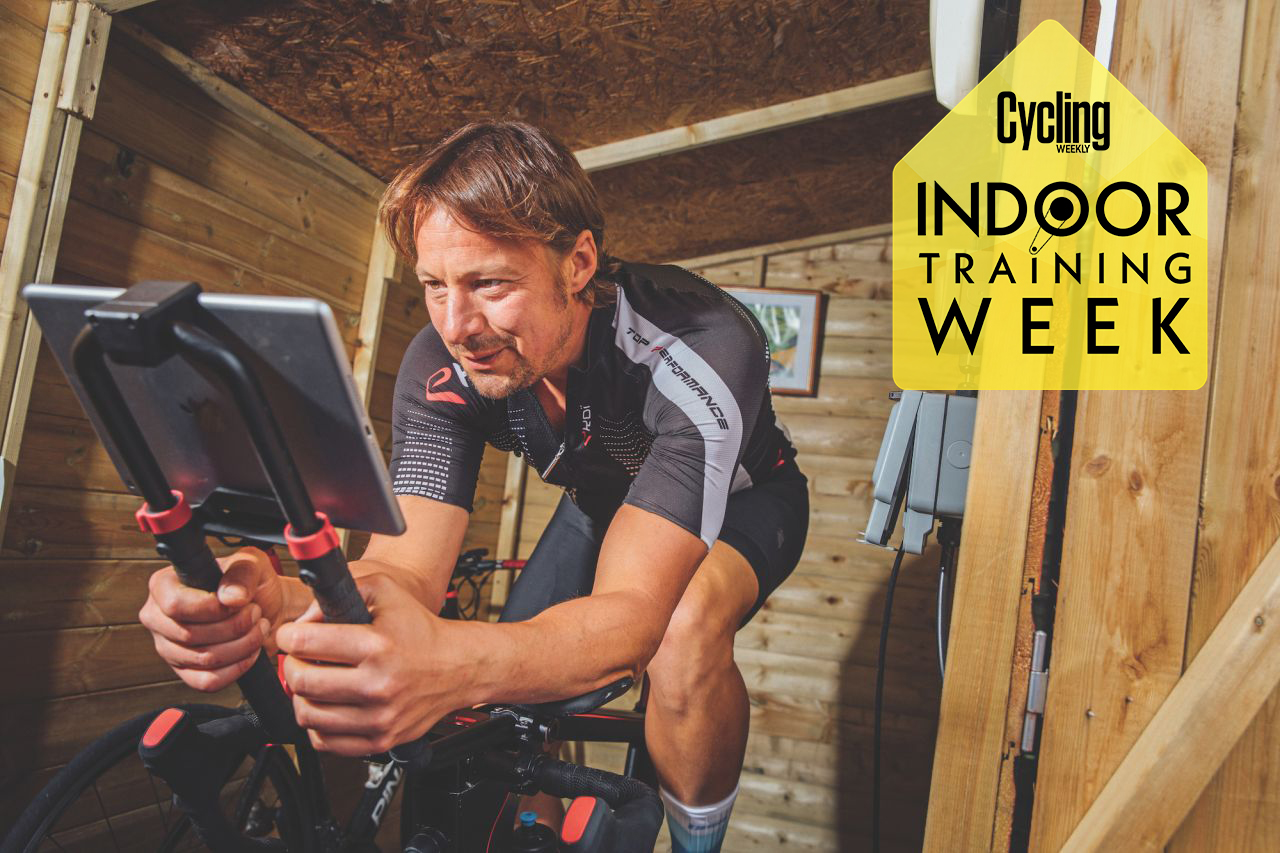
As the end of our 2020 locked-down summer approached, it was time for a personal stocktake: what had I achieved? I’d accrued a few dozen hours of aimlessly ambling around Zwift’s virtual parcours; I’d tried and failed to teach my daughters long division; oh, and there was a notable increase in empty bottles of booze amassing in the recycling bin. I had become directionless. Bereft of my usual way of life, I’d become a jack of all trades: an imitation maths teacher, a pseudo-cyclist, a semi-professional imbiber of premium strength lager beer.
Something needed to change – ideally the erasure of this blasted virus – but failing that, I needed a cycling target achievable in these restricted times.
The virtual time trialling scene is – thanks to Covid restrictions – was booming, with events of various distances on flat, undulating and mountainous courses regularly popping up on the Zwift calendar. I bought into this and raced countless virtual TTs over the course of lockdown. Road racing on Zwift, although fun, had started to get a little demoralising – my comparatively hefty 83kg pins my FTP to around 4.4w/kg, meaning that in A-category races, the merest suggestion of a slope leaves me reeling in the red, before being promptly spat out the back. On the other hand, in a race against the clock on a flat course, comparative heft is no disadvantage.
The question was, could I train to excel in Zwift TTs in a way that would result in real-world improvement too, ready for when restrictions were lifted?
Indoor disciplines
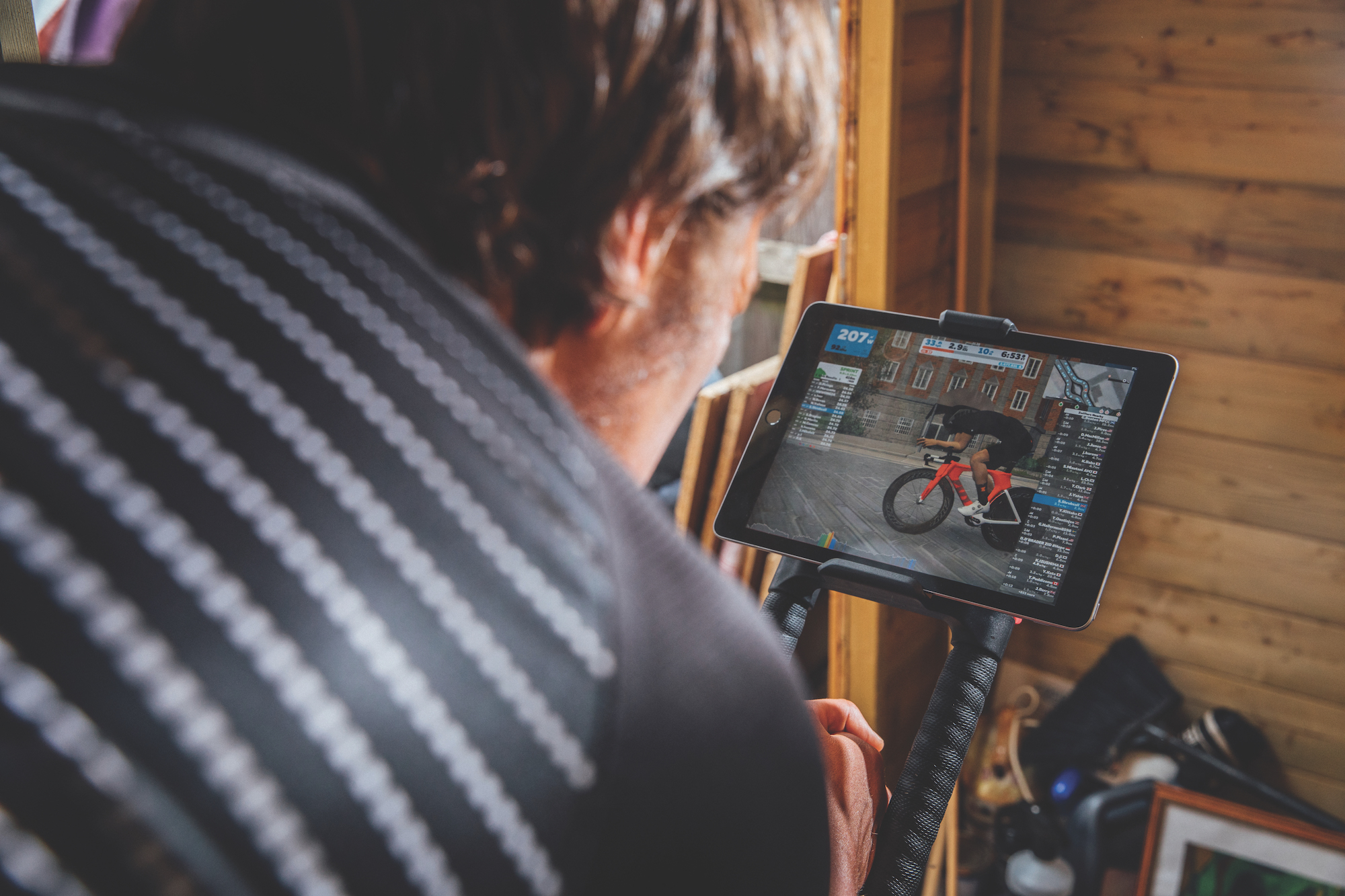
With a huge array of training sessions and events available online, I wanted to know which would give me most bang for my buck. It was time for a word or two of wisdom from one of Zwift’s most prolific time triallists, Ed ‘Cleatless’ Ray – winner of just about every race of truth he enters online. What does he attribute his success to?
“I acquit myself far better in TTs on Zwift than in outdoor races,” admits Ray, “due to having a decent threshold capacity, but hopelessly limited peak power. The disciplines of indoor and outdoor racing differ greatly.”
According to Ray, you need experience on Zwift and a deep understanding of its quirks. “Adapting to the platform’s frequently debated physics can be a tricky task, almost akin to learning a completely novel form of cycling.”
Get The Leadout Newsletter
The latest race content, interviews, features, reviews and expert buying guides, direct to your inbox!
If Zwifting is a cycling discipline in its own right, would it be of limited use in making me good at racing outdoors too?
“On the contrary. Though relying exclusively on [indoor cycling] to accomplish a goal outdoors might seem illogical, I think it’s generally more efficient,” says Ray. “Using structured intervals, competing in events, as well as impulsive freestyle sessions, perhaps using music to dictate power and cadence, I’ve added roughly 60 watts to my FTP – and even reduced my bodyweight by a kilogram.”
Ray doesn’t ride solely indoors; his nickname ‘Cleatless’ references his jaunts on his flat-pedalled road bike on the roads in and around the South Downs. I was yet to learn how to best combine my indoor and outdoor training.
My next source of expert advice was a time triallist who has proven form both virtually and in the real world. An erstwhile national record holder, Rachael Elliott holds countless Strava trophies and course records, as well as boasting an eye-watering FTP of over 5.3w/kg.
Having suffered a stroke in 2018, Elliott now races on a tandem and regularly tops the results in her club Newbury Velo’s midweek TT on Zwift. It was this event that first piqued my interest in Zwift TTs – witnessing riders like Elliott and Ray setting big benchmarks while the rest of us ate their virtual dust. Having achieved success inside and out, Elliott seemed the ideal person to advise me on the differences between the two.
“I personally find TTs easier indoors,” she says. “Maybe because you can completely control your efforts and you don’t have to worry about any external factors.”
Simply put, there are more variables outdoors.
“When I line up for a race on the road, I’m worried about what cars I’ll meet at the turn, avoiding people, punctures, that sort of thing,” adds Elliott. “You can measure your effort better indoors. My power is better indoors too.”
However, higher power figures and a more measured effort don’t necessarily equate to the best results: “You definitely go faster outdoors. I don’t think there’s enough difference in Zwift speeds across the field, so things like drag coefficient are not really recognised. Indoors, I could do a middling 20 [minutes, for 10 miles] while outdoors I could do a middling 19.”
The same does not apply to newer riders, explains Elliott: “Often, people who struggle to do a 30-minute ‘10’ outside are able to ride 26 minutes on Zwift. We find the top-end riders don’t go as fast, but the beginners can go faster.”
In the highly-controlled environment of virtual racing, what makes one rider faster than another, aside from fitness and power levels, is an algorithm dictating ‘virtual drag’ based on height, weight and the equipment you choose from your virtual shed. This levels the playing field from a financial point of view. Can’t afford that super-duper mega aero featherweight disc wheel? Nil desperandum, head forth to the ‘drop shop’ and buy one with some pretend money. Can’t stretch the savings for a day in the wind tunnel? Not an issue. Neither can anybody else. Zwift doesn’t have a wind tunnel, it just has an algorithm.
But what if I did have a bank account fit to burst with hard currency? How effectively could I convert my indoor-won fitness gains to fast outdoor performances? It was time to enlist the help of a real connoisseur of efforts against the clock, someone who makes a living from making the most from every single watt. Dan Bigham has orchestrated time-trialling triumphs for the likes of Huub-Wattbike and the Danish pursuit squad, and now he was on hand to make my lockdown project a resounding success, hopefully.
“If you look back, there’s a lot of people who’ve done well purely off indoor training: Steve Cummings at the 2017 Nationals – he broke [a bone] a couple of months out and lived on the turbo, then rocked up and won the time trial and the road race.”
What makes indoor training so effective, in Bigham’s view?
“There’s little waste in what you do on a turbo; there are no head- or tailwinds, you’ve just gotta ride. It’s so good and so pure for clean and quality training.”
Different strokes
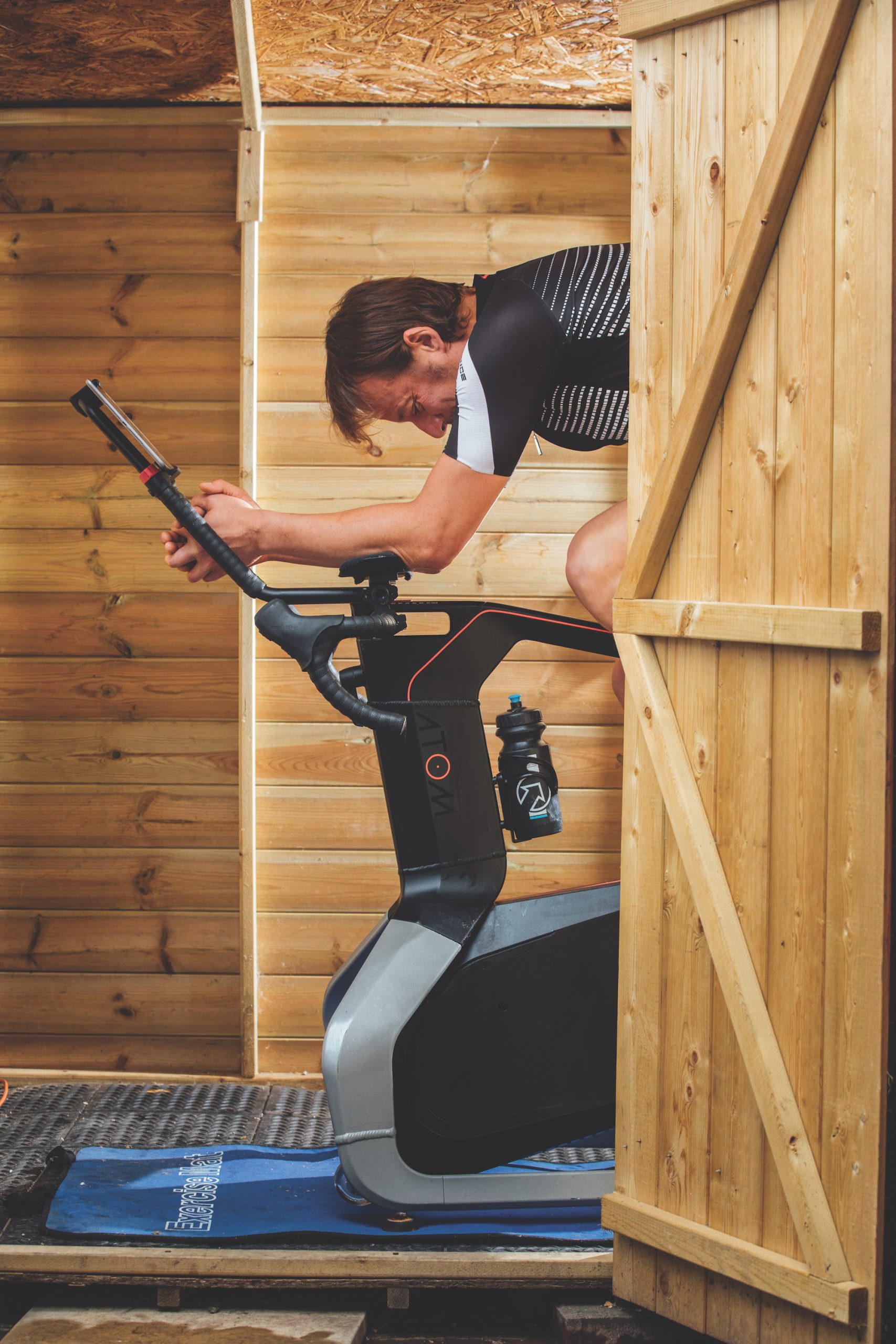
Of course, turning indoor gains into outdoor speed, requires specific attention to the demands of holding an aero position.
“If you train in the aero tuck, your physiology will eventually adapt and you’ll be able to produce the same wattage [as in your normal position] or within 10 per cent of it.”
So how could I use Zwift to produce an outdoor TT PB?
“The biggest thing that you lose when training indoors is the familiarity of what it’s like to ride in a tucked position on the course you’re going to race on,” says Bigham, “including what gears you’re going to be in, and how you’re going to take certain corners.”
It was beginning to feel like information overload. I asked Bigham to put my priorities in order.
“The priority is position – the quickest and easiest thing to do is typically to get narrow and have a low-tucked head position. Next is a really good clothing set-up: aero socks, over-shoes, and a skinsuit. This could literally knock minutes off 10- and 25-mile TTs.”
The final pillar in Bigham’s holy trinity of gains concerned my bike.
“The third one is tyres and tubes – they are such good value for money when you look at the pounds-per-watts scale. It makes sense to get a faster clincher or tubeless set-up. Most people don’t understand how big a difference tyres make.”
Armed to the teeth with expert advice, I began my time trialling journey, starting with a globe-trotting tour of Zwift. I made strength gains by doing high-torque sessions on New York’s highway in the sky; I spent quality time in sweetspot around the streets of London; and I used Alpe du Zwift as a go-to tempo session. Oh, and who could forget the desert plains of Tempus Fugit for a humbling two times 20-minute FTP workout – the cornerstone of any TT training plan worth its salt.
Despite my considerable indoor schedule of sessions, most of my training came by way of racing in virtual events. The first real lockdown race to gain any kind of nationwide notoriety was the Newbury Velo midweek TT. In the first month or so it attracted hundreds of riders, all keen to flex their slow-twitch endurance fibres online in lieu of the usual evening dual- carriageway affairs.
Having boosted my FTP to 4.4w/kg, I was able to give a reasonable account of myself. The parcours of choice was Tempus Fugit, an 11.2-mile, pan-flat out-and-back, during which you have very little to focus on save for the amount of pain you are inflicting on yourself. By the end of the race, slumped over the bars, hallucinating through a fug of my own frantic exhalations, I found it was a near-death experience very much worth having. Sixteenth out of nearly 400 riders in a time of 23:53 – pretty much epitaph-worthy!
Taking confidence from my training while heeding words of advice from the experts, I stumbled upon a real-world TT that was almost an exact replica of the Tempus Fugit virtual course – almost the same length (I would take this into account when comparing the times) and with the same amount of ascent (none).
So it came to pass on a warm morning in late August that I arrived at Goodwood race circuit, near Chichester in West Sussex, with a view to categorically dispatching the entire field. Failing that, not coming last would suffice. In seriousness, my main aim was to cook the effort correctly and ideally finish a hair’s breadth away from losing control of my bodily functions; everything was going to have to be left out there on Goodwood’s hallowed Tarmac.
Down to business
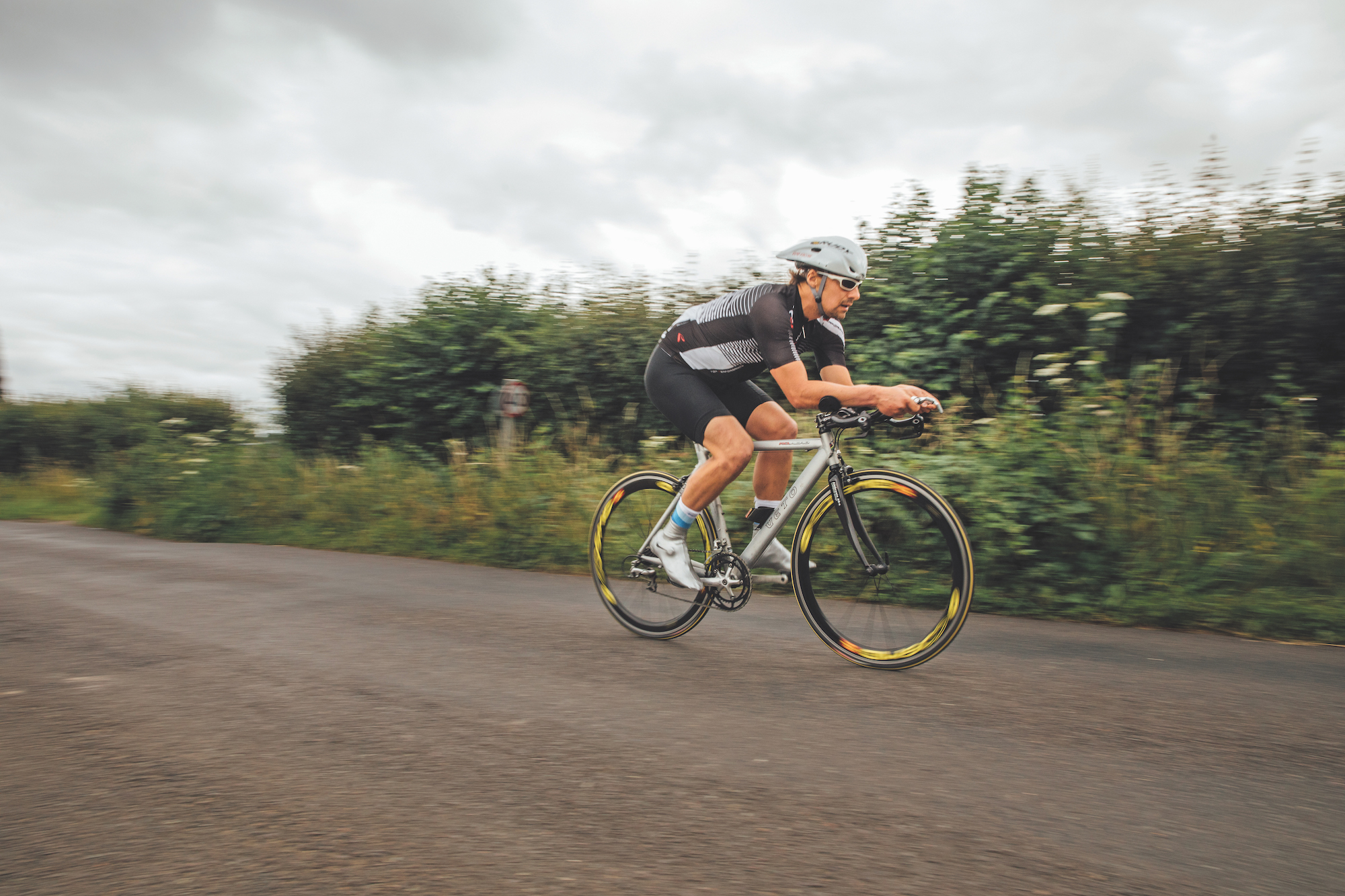
Now for a ‘dog ate my homework’ excuse: the evening before the race, I noticed my dog Arthur attempting to consume a large piece of plastic. It wasn’t until I saw a strap fall from the side of his mouth and a C2032 battery being spat out that I realised – the horrible hound had munched my heart rate monitor. Being without a critical barometer of my effort in the TT, I had to rely largely on perceived effort. Backing off perhaps a little too much after an exuberant start, I reached the chequered flag in a time of 27:58 (over 11.2 miles), with a little too much in the tank for my liking, finishing midpack on the final results sheet.
I could blame the lack of HRM, the headwind, the early start... but the truth is that, whereas on Zwift I can literally put my head down and concentrate on nothing but turning the pedals with as much power as possible, I was very much unprepared for the extrinsic factors in the great outdoors: maintaining an efficient aero tuck, a stubborn headwind on one section of the course, overtaking (or being overtaken by) other riders, all played a part in a comparatively lacklustre performance.
My focus had deviated from getting the most from my body to the external distractions, and staying ‘in the zone’ proved much more difficult. My fluctuating effort and final time – four minutes slower than my best effort indoors – goes some way to illustrating that riding inside and out are mutually exclusive disciplines.
The former requires raw wattage and arguably a higher tolerance for pain (there’s no respite indoors). In terms of turning indoor pain into outdoor gain, your suffering inside the four walls of your garage or shed will never garner the desired results outdoors without a whole lot of thought, practice and refinement of position, kit and clothing.
Yes, training inside certainly has a positive impact on your performance, but the main act outdoors will require many dress rehearsals.
CW’s weekly event on Zwift came at just the right time for me to tune my TT engine. Free to join, it gives those who aren’t averse to a little pain of a Wednesday evening the chance to pit themselves against CW’s and Zwift’s finest – Doctor Hutch and Ed ‘Cleatless’ Ray included. The race attracts over 100 competitors every week, of all abilities.
Despite the size and depth of the field on the first race of the series, my focus had zeroed in on one person, namely this publication’s fitness editor David Bradford. It was time to repay the beating I had received in our summer virtual crits.
I could see his avatar just a few slots before me on the starting grid, nonchalantly turning the pedals in the air-conditioned plushness of his home health and fitness studio, a final delivery of beetroot juice and caffeine no doubt being administered while his own private team of soigneurs queued patiently to mop his brow and tend to his hydration requirements. And then he was off...
Unfortunately, never to be seen again during that particular 20 minutes, which made it all the more harrowing. But my time will come.
This 2020 feature originally appeared in the print edition of Cycling Weekly, on sale in newsagents and supermarkets, priced £3.25.

Thank you for reading 20 articles this month* Join now for unlimited access
Enjoy your first month for just £1 / $1 / €1
*Read 5 free articles per month without a subscription

Join now for unlimited access
Try first month for just £1 / $1 / €1
Steve has been writing (mainly fitness features) for Cycling Weekly for 11 years. His current riding inclination is to go long on gravel bikes... which melds nicely with a love of carbs
-
 Gear up for your best summer of riding – Balfe's Bikes has up to 54% off Bontrager shoes, helmets, lights and much more
Gear up for your best summer of riding – Balfe's Bikes has up to 54% off Bontrager shoes, helmets, lights and much moreSupported It's not just Bontrager, Balfe's has a huge selection of discounted kit from the best cycling brands including Trek, Specialized, Giant and Castelli all with big reductions
By Paul Brett
-
 7-Eleven returns to the peloton for one day only at Liège-Bastogne-Liège
7-Eleven returns to the peloton for one day only at Liège-Bastogne-LiègeUno-X Mobility to rebrand as 7-Eleven for Sunday's Monument to pay tribute to iconic American team from the 1980s
By Tom Thewlis
-
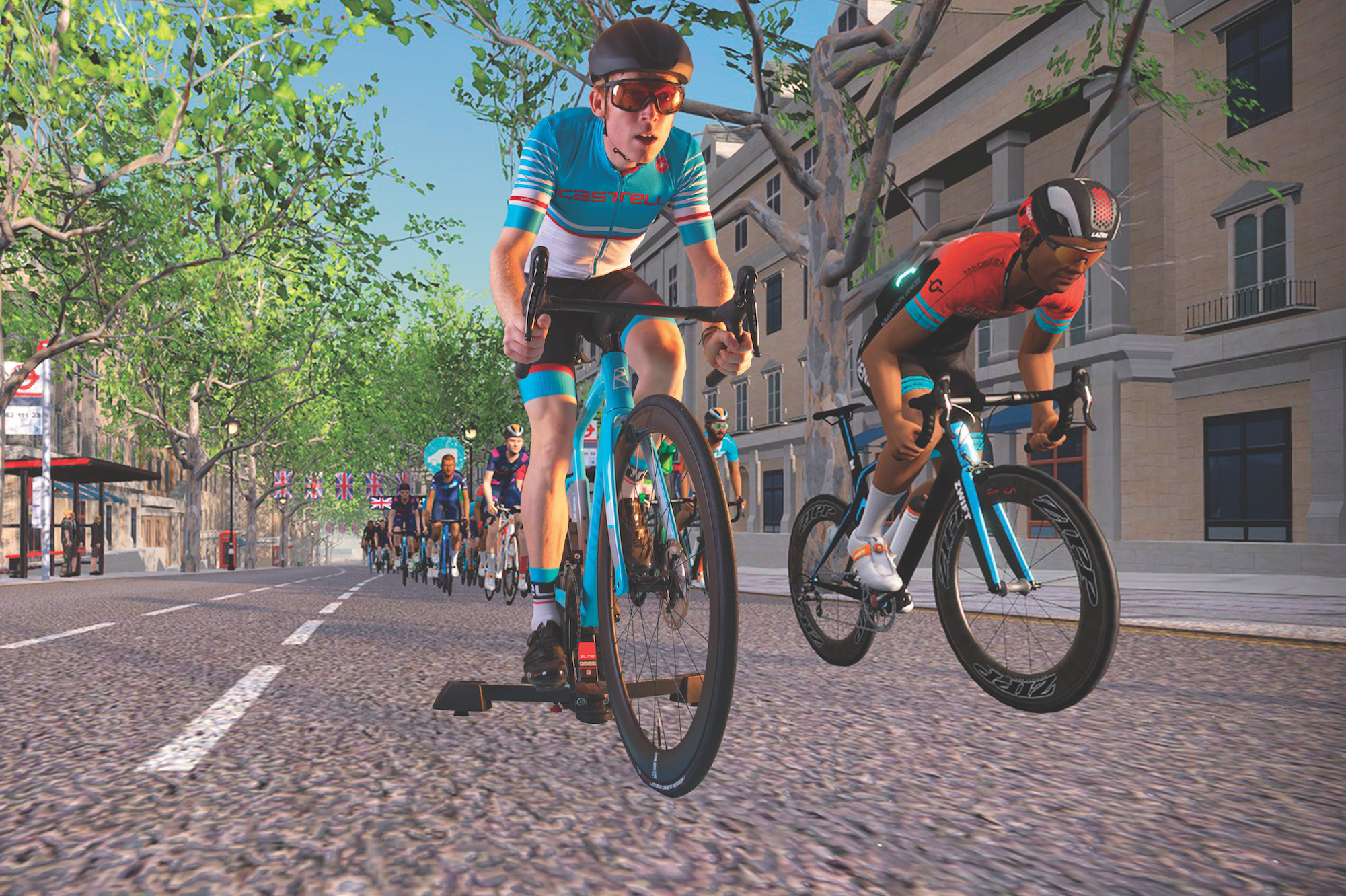 11 things you only know if you race on Zwift
11 things you only know if you race on ZwiftFrom power-ups to pushing watts – a few lessons we learned the hard way
By Alex Ballinger
-
 Online talent spotting - what it takes to get noticed on Zwift
Online talent spotting - what it takes to get noticed on ZwiftThe pathway to the top tier of cycling looks like a map of the London Underground. Starting at Club Network, the high-aspiring cyclist will be calling at the Development Centre, the Regional School of Racing, the National School of Racing, the Junior Academy, the Podium Programme and finally fame, glory and a summit finish victory in yellow on Mont Ventoux
By Simon Richardson